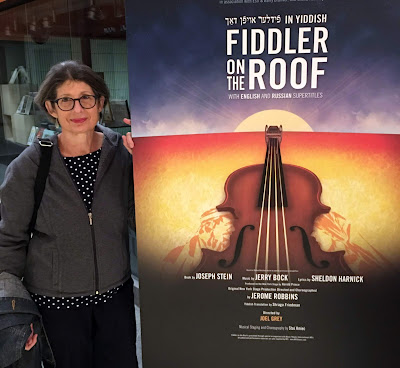The very first Broadway musical I ever went to see was Fiddler on the Roof. There were very few days my grandmother left the house or took a trip with us, but Baboo came with us that day. The story of Fiddler was a performance of her life on a stage. I am not sure she would have recalled her childhood as moments set to music, but I bet there were enough of the traditions in Anatevka to bring back memories of her shtetl. I only wish I could recall the conversations in the car on our way home that afternoon. She must have had much to say about the authenticity of it all.
My daughter would have also enjoyed that car ride home. She would have held Baboo's hand and listened with empathetic patience, as that is what she does best. There is just so much Katie can learn from her trips to Ancestry.com and the DNA test revealing she is 100% Eastern European. (No surprise there.) The key to her roots lies in the memories of her great-grandparents, many of which were recalled on the stage of a Broadway show.
The soundtrack to Fiddler on the Roof filled our car radio for many years. We all love the music and sang along in voices Sam would cringe at today. At Camp Kinder Ring, my son played a powerful Tevye with a voice as deep and glorious as Zero Mostel. I suppose he has the right to comment on his mother's lack of musical ability.
I can't dance either, but I did sway to Sunrise Sunset with my dad at my own wedding, giving my mom a good reason for her tears.
There was something so special, so right, about experiencing Fiddler on the Roof in Yiddish. Sam and I had seats to a Saturday night performance at the Museum of Jewish Heritage in Lower Manhattan. We both loved this show on so many levels. Sam knew a few of the actors on stage and he could truly recognize and applaud the talents of his friends.
I was told I would not appreciate seeing this show in another language. I was told by my stepmom that only those closest to her generation would grasp the true meaning of the story and the impact of the Yiddish translation.
But the thing is, I know the story well. I did not need the translations offered on the sides of the stage. This was my first and my favorite show. I watched my kids and my husband perform their roles on the stage in camp and I must have painted flats with the village of Anatevka for camp and school at least three times. I could recite the words of many of the scenes.
I know this show well, this story about my grandmother's childhood.
 |
| Baboo and me |
It seems I also knew enough Yiddish to follow along. It is amazing how a language spoken in my childhood stayed with me all these years. I listened to the actors, glanced at the subtitles on the side of the stage and the essence and flavor of their voices brought it all home. It is the language of my family. Indeed, there was something so right about experiencing it in Yiddish.
This is the story of Baboo and many others, this story of Tevye and his family struggling to keep their traditions alive in a changing world. And it was presented in a language that is dying along with the generation of people who can still remember those days.
Fiddler on Roof in Yiddish has been extended through December. Go experience it.






No comments:
Post a Comment